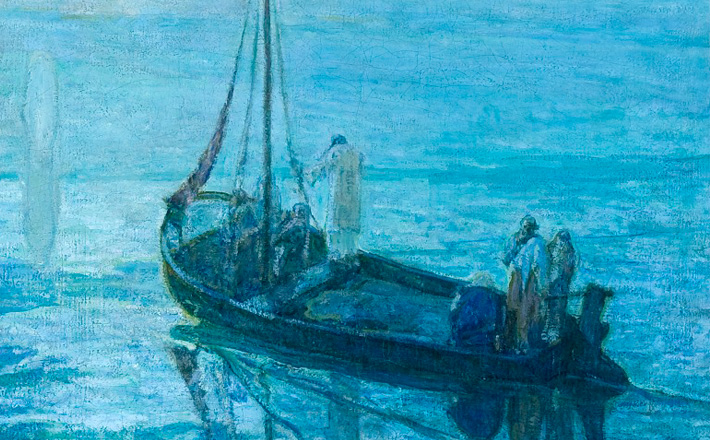Commentary on Matthew 14:22-33
It is among the masses in Galilee that Jesus commences his healing and teaching ministry.1
Jesus’ popularity as a man who can heal whatever ails a person spreads beyond the Galilean borders. Jesus’ newly acquired celebrity attracted enormous crowds; the crowds consisted of the infirm and their caregivers and friends, as well as curious, fascinated, and antagonistic fans and tag-alongs (Matthew 4:23-25; 8:1-4, 19-22; 9:14). Jesus will develop ambivalence toward the constant press of crowds, oscillating between engaged compassion and crowd-fatigue. Most healer-teacher-preachers are energized and encouraged when the crowds show up to receive the gifts of their vocation, but all humans have limits and need boundaries, space, and time for self-care apart from the crowds and from their inner circle of confidants. Jesus was craving this kind of reprieve immediately before his disciples are haunted by him walking on the stormy sea (Matthew 14:13, 22).
The story of Jesus walking on the Sea of Galilee is preceded by the narrative of the feeding the 5,000-plus (Matthew 14:13-21); a healing summary follows it (14:34-36). In all three narratives the crowds play a significant role. In the preceding narrative, Jesus tries to retreat into an isolated place, perhaps needing space to grieve the murder of John the Baptist; however, he is drawn back into the crowd and their needs (14:13-21). Jesus momentarily sacrifices self-care to attend to the crowds. The disciples urge Jesus to dismiss the crowds, presuming that the entire crowd has the means and ability to trek into the city to buy food. This won’t be the first time the disciples urge Jesus to send folks packing (15:23). But perhaps, in this case, Jesus’ inner circle sensed that Jesus needed some self-care—time to be alone and relax.
We all variously allow our callings to blind us to our limitations and the long term effects of neglecting self-care. But more importantly, we can forget that we are not God! And when we leave the earth, others will or will not carry on; over that we have no control. When I left home to attend college to prepare for my vocation, it was difficult and painful leaving my mother’s side. She was an invalid and I was the only child still home to assist her and look out for her. I cried myself to sleep nights in my dorm room; I felt I should be doing something more to help my mother (even though I was able to obtain work the second day in my new city to send money home). My mother said she just wanted me to be happy. But it was God, I like to believe, who reminded me one night, through my tears, that God can do what I cannot do, in my presence and in my absence.
Jesus, like many people called into ministry, had a passion for the people and sometimes passion and enthusiasm pushes self-care to the curb. A fully embodied ministry is one characterized by self-care. Self-care is a divine gift. Jesus was human like us and could convince himself that there is only one person and one way to fulfill the significant and daunting needs of the masses. Interestingly, our story is followed by a summary of the many crowds that pursued Jesus on the other side of lake. So great is the need and so massive the crowd, that the people themselves imagine a way that this one human being could meet as many of their needs as possible—by touching the fringe of his cloak. What happens when the fringes wear out?
Unable to escape the crowds, Jesus is so starving for self-care that he sends his disciples away in a boat, alone cross the lake before nightfall. Jesus risks being stranded without a boat. The narrator states that in the evening the boat carrying the disciples was battered by the waves and far from the shore (Matthew 14:23). Jesus had no boat. And Jesus stayed put. He did not panic; he chose to be fully present in his space and time alone (monos). We can’t jump for every storm and embody self-care too! Perhaps, God has another plan and another woman or man or a way out of no way! Jesus dismissed the crowds and sought a solitary place up in the mountain where he talked to God and rested. After Jesus’ spirit, mind, and body were rejuvenated, Jesus arose early in the morning—refreshed and looking good, I imagine—and walked on the sea toward his disciples. But the disciples think that Jesus is a ghost. Terrified, they scream. “Instantly, Jesus said to them, ‘Stay calm, it is I; don’t be afraid.’ Peter responds, ‘Master, if it is really you, command me to join you on the water.’ Jesus responded, ‘Come! [if you insist]’” (Matthew 14:27-28, my translation). Peter disembarks onto the water and walks around a bit and heads toward Jesus. Let’s be real. Feeding a mass of people with a few loaves of bread and fish is not the same as walking on water!
Peter soon discovers that it is one thing to be battered by strong winds while in the same boat with others . It is a whole other matter to be on the water surrounded by strong winds and all by yourself, without others who share in the same vulnerability. Jesus and Peter were not “in the same boat”; Jesus had evidently walked on the choppy sea of distress for some distance, from shore to boat in the fierce winds. Peter had not. Yes, Jesus chastised Peter when he notices the winds and begins to sink; Jesus accuses him of doubting and having little faith. Sometimes faith is seeing the boat for what it is—a shared experience and the opportunity to lean on one another, to encourage each other in the storm while waiting on God. Peter was eager to leave his shipmates and to join Jesus, rather than to wait for Jesus to join them in the boat. Sometimes we want our own miracle at the expense of others who are in the same boat as us. Jesus reached out his hand and caught Peter, and they both got into the boat with the other disciples. It is when they are all in the boat together with Jesus that the winds calm down.
Few readers focus on the miracle of Jesus walking on the water. The spotlight is usually placed on Peter’s momentary walk on the water and his failure to maintain that walk because of his shifted focus from Jesus to the winds. Perhaps it is as significant that Jesus is able to walk on the water so as to reengage in his ministry after some much needed self-care. Perhaps, Jesus looks like a ghost because the Jesus that the disciples left on the other side of the sea looked overworked, fatigued, drab, and unsteady. Perhaps they were not accustomed to seeing Jesus look so rested, in control, and peaceful; thus, they think he is a ghost. Sometimes we are haunted by visions of our better selves. Our better selves are such an improbability for us that to see it, to envision it and what it may take to achieve our better selves is a haunting. We are haunted by better days that seem to escape us. Sometimes we get ourselves in such a rut of not taking care of ourselves, of not exercising, of not sleeping well or barely sleeping, of not eating properly, that to live otherwise haunts us. Bell hooks in her book Sisters of the Yam states that self-care is a political act of resistance for black women. Self-care may be a political act of resistance for anyone overwhelmed by challenges caused by the superman or superwoman syndrome and/or by the perennial onslaught of sexism, racism, classism, heterosexism, disability, or other forms of oppression (and being the oppressor is destructive as well).
After his time of self-care, Jesus is empowered from his head to the sole of his water-walking feet and at the fringe of his garment (14:34-36). When Jesus reaches land he doesn’t have to do all the heavy lifting; the people empower themselves and are healed by merely touching the hem of his cloak, something that hadn’t happened since the early part of his ministry (Matthew 9:20-21).
Notes
- Commentary first published on this site on Aug. 13, 2017.


August 9, 2020